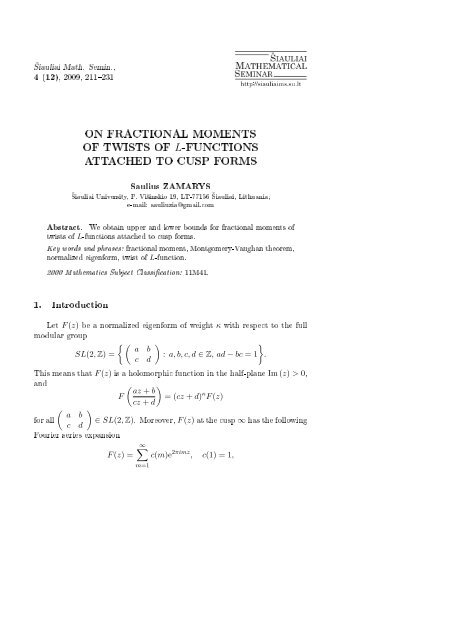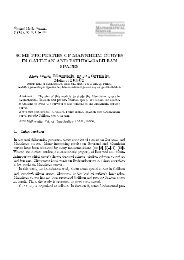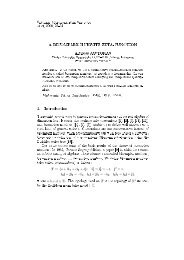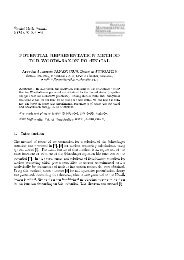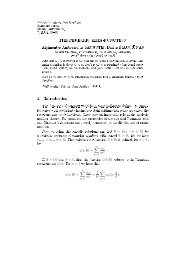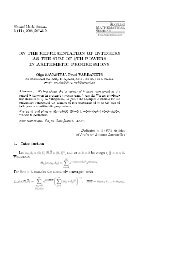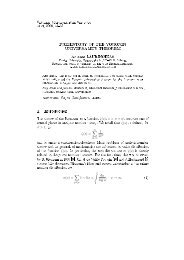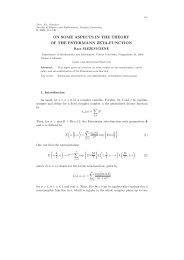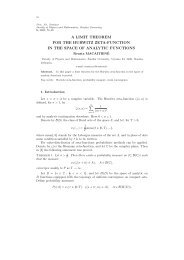on fractional moments of twists of l-functions attached to cusp forms
on fractional moments of twists of l-functions attached to cusp forms
on fractional moments of twists of l-functions attached to cusp forms
Create successful ePaper yourself
Turn your PDF publications into a flip-book with our unique Google optimized e-Paper software.
’iauliai Math. Semin.,4 (12), 2009, 211231ON FRACTIONAL MOMENTSOF TWISTS OF L-FUNCTIONSATTACHED TO CUSP FORMSSaulius ZAMARYS’iauliai University, P. Vi²inskio 19, LT-77156 ’iauliai, Lithuania;e-mail: sauliuzia@gmail.comAbstract. We obtain upper and lower bounds for fracti<strong>on</strong>al <strong>moments</strong> <strong>of</strong><strong>twists</strong> <strong>of</strong> L-functi<strong>on</strong>s <strong>attached</strong> <strong>to</strong> <strong>cusp</strong> <strong>forms</strong>.Key words and phrases: fracti<strong>on</strong>al moment, M<strong>on</strong>tgomery-Vaughan theorem,normalized eigenform, twist <strong>of</strong> L-functi<strong>on</strong>.2000 Mathematics Subject Classicati<strong>on</strong>: 11M41.1. Introducti<strong>on</strong>Let F (z) be a normalized eigenform <strong>of</strong> weight κ with respect <strong>to</strong> the fullmodular group{ ( ) a bSL(2, Z) =c d}: a, b, c, d ∈ Z, ad − bc = 1 .This means that F (z) is a holomorphic functi<strong>on</strong> in the half-plane Im (z) > 0,and)F( az + bcz + d)= (cz + d) κ F (z)for all ( a b∈ SL(2, Z). Moreover, F (z) at the <strong>cusp</strong> ∞ has the followingc dFourier series expansi<strong>on</strong>F (z) =∞∑c(m)e 2πimz , c(1) = 1,m=1
212 S. Zamarysand F (z) is a simultaneous eigenfuncti<strong>on</strong> <strong>of</strong> all Hecke opera<strong>to</strong>rs(F |T (m))(z) = m κ−1 ∑0 κ + 1 ,2m=1is called the L-functi<strong>on</strong> <strong>attached</strong> <strong>to</strong> the <strong>cusp</strong> form F (z). Now let χ be aprimitive Dirichlet character modulo q. C<strong>on</strong>sider a twist L(s, χ, F ) <strong>of</strong> thefuncti<strong>on</strong> L(s, F ) dened, for σ > κ+12, byL(s, χ, F ) =∞∑m=1c(m)χ(m)m s .Moreover, the functi<strong>on</strong> L(s, χ, F ) is analytically c<strong>on</strong>tinuable <strong>to</strong> an entirefuncti<strong>on</strong>, and satises the functi<strong>on</strong>al equati<strong>on</strong> [4]( ) 2π −sΓ(s)L(s, χ, F )qwhere= (−1) κ 2( |τ(χ)|) 2 ( 2πqτ(χ) =) κ−sΓ(κ − s)L(κ − s, χ, F ), (1)q∑χ(m)e 2πi m qm=1is the Gaussian sum, and Γ(s) denotes the Euler gamma-functi<strong>on</strong>. Let C bethe complex plane. Then { s ∈ C : κ 2 σ κ+1 } 2is called the critical strip forthe functi<strong>on</strong> L(s, χ, F ). Moreover, the analogue <strong>of</strong> the Riemann hypothesisasserts that all n<strong>on</strong>-trivial zeros <strong>of</strong> L(s, χ, F ) lie <strong>on</strong> the critical line σ = κ 2.In view <strong>of</strong> the multiplicativity <strong>of</strong> the coecients c(m), L(s, χ, F ) also has anEuler product representati<strong>on</strong>L(s, χ, F ) = ∏ p= ∏ p(1 − χ(p)c(p)p −s + χ 2 (p)p κ−1−2s ) −1(1 − α(p)χ(p) ) −1 (p s 1 − β(p)χ(p) ) −1p s
On fracti<strong>on</strong>al <strong>moments</strong> <strong>of</strong> <strong>twists</strong> <strong>of</strong> L-functi<strong>on</strong>s... 213over primes p, where c(p) = α(p) + β(p). By Deligne's pro<strong>of</strong> [1] <strong>of</strong> the Weilc<strong>on</strong>jecture, we have|c(m)| m κ−12 d(m),where d(m) denotes the divisor functi<strong>on</strong>, and|α(p)| p κ−12 , |β(p)| pκ−12 . (2)The aim <strong>of</strong> this paper is <strong>to</strong> obtain estimates for fracti<strong>on</strong>al <strong>moments</strong> <strong>of</strong> thefuncti<strong>on</strong> L(s, χ, F ).Let, for k 0 and σ κ 2,I k (T, σ, χ, F ) = I k (σ, χ, F ) =∫ T0|L(σ + it, χ, F )| 2k dt.The rst results <strong>on</strong> the <strong>moments</strong> <strong>of</strong> the functi<strong>on</strong> L(s, χ, F ) were obtained byKamiya. He proved [4] the estimate∑∫ T∗χ mod q−T|L(σ + it, χ, F )| 2 dt ≪ φ(q)T log(qT ),uniformly for κ 2 − 1log(qT ) σ κ 2 + 1log(qT )and q. Here φ(q) is Euler's <strong>to</strong>tientfuncti<strong>on</strong>, and ∑ ∗denotes the summati<strong>on</strong> over primitive characters.Now we recall some mean-value results for L(s, F ). LetI k (T, σ, F ) =∫ T0|L(σ + it, F )| 2k dt.The rst mean value result for L(s, F ) bel<strong>on</strong>gs <strong>to</strong> H. S. A. Potter. In [10],he proved that, for σ > κ 2and T → ∞,I 1 (T, σ, F ) ∼ T∞∑n=1c 2 (n)n 2σ ,and in [11] he obtained the estimate I 1 (T, κ 2, F ) ≪ T log T. Later, A. Good[3] found the formulas⎧⎪⎨I 1 (T, σ) =⎪⎩2κA F T log T + O(T ) if σ = κ 2 ,A F (σ)T + O(T κ+1−2σ κ) if2 < σ < κ+1A F (σ)T + O(log 2 T ) if σ = κ+12 .2 ,
214 S. ZamarysIn [7], fracti<strong>on</strong>al <strong>moments</strong> <strong>of</strong> L(s, F ) were investigated, and lower and upperbounds for them were obtained. Let k = n, 1 where n is a positive integer.Then [7](I k T, κ )≫ T (log T ) k2 . (3)2Let k = n, 1 where n is an even positive integer. Then, under the analogue <strong>of</strong>the Riemann hypothesis [7],(I k T, κ )2≪ T (log T ) k2 . (4)In [6], estimates (3) and (4) were generalized for other values <strong>of</strong> k. The case(3) was proved for k = l nwith l, n ∈ N, (l, n) = 1, and k 1 2. The estimate(4) was reached under the assumpti<strong>on</strong> <strong>of</strong> the analogue <strong>of</strong> the Riemann hypothesisfor L(s, F ). This case was proved for k = l n 1 2, where l, 0 < l < 2,is an arbitrary number, and n ∈ N is even.The aim <strong>of</strong> this paper is <strong>to</strong> obtain similar results for fracti<strong>on</strong>al <strong>moments</strong><strong>of</strong> L(s, χ, F ). For xed k and q, we will investigate the estimatesandI k( κ2 , χ, F )≫ T (log T ) k2 (5)I k( κ2 , χ, F )≪ T (log T ) k2 , (6)and we will prove the following statement.Theorem 1. Let T → ∞. Then the following statements hold:(i) when k = l n 1 2, l, n ∈ N,(l, n) = 1, then the estimate (5) holds;(ii) under the analogue <strong>of</strong> the Riemann hypothesis for L(s, χ, F ), when k =ln, where l, 0 < l < 2, is an arbitrary number, and n ∈ 2N, thenestimate (6) holds.2. Estimati<strong>on</strong> <strong>of</strong> Dirichlet polynomialFrom the Euler product we obtain that, for σ > κ+12,L k (s, χ, F )= exp {k log L(s, χ, F )}
On fracti<strong>on</strong>al <strong>moments</strong> <strong>of</strong> <strong>twists</strong> <strong>of</strong> L-functi<strong>on</strong>s... 215{= exp −k ∑ p= ∏ p= ∏ p( (log 1 − α(p)χ(p) )p sexp { ( (−k log 1 − α(p)χ(p) )p s(1 − α(p)χ(p)p s ) −k (1 − β(p)χ(p)p s ) −k.Therefore, we have that, for σ > κ+12,L k (s, χ, F ) =∞∑m=1(+ log 1 − β(p)χ(p) )) }p s(+ log 1 − β(p)χ(p) ))}p sg k (m)χ(m)m s ,where g k (m) is a multiplicative functi<strong>on</strong> given bywhereg k (p l ) =l∑d k (p j )α j (p)d k (p l−j )β l−j (p), l ∈ N,j=0d k (p j ) =k(k + 1) . . . (k + j − 1), j ∈ N.j!Moreover, the functi<strong>on</strong> d k (m), m ∈ N, is multiplicative and satisesd k (m) ≪ m ε for all m ∈ N,and d k (p) = k for prime p. Now we will prove <strong>on</strong>e lemma.Lemma 1. For any xed 0 < k 1 2and some c<strong>on</strong>stant c > 0, uniformly inσ, κ 2 + clog N σ (κ+1)2, the estimatesandhold.(σ − κ ) −k 2≪2(log N) k2 ≪N∑m=1N∑m=1g 2 k (m)|χ(m)|2m 2σ≪(σ − κ ) −k 22g 2 k (m)|χ(m)|2m κ ≪ (log N) k2 .
216 S. ZamarysPro<strong>of</strong>. Firstly, we dene functi<strong>on</strong> h(m) = g 2 k (m)m1−κ |χ(m)| 2 . We willc<strong>on</strong>sider the mean value ∑ mxh(m). In view <strong>of</strong> the deniti<strong>on</strong> for g k (p l ), wehave g k (p) = d k (p)(α(p) + β(p)) = kc(p). Let, for brevity, c p = c(p)p 1−κ2 .Then we have that h(p) = k 2 c 2 p|χ(p)| 2 . Now we will use <strong>on</strong>e result <strong>of</strong> Grupp[4]∑pxp≡a mod qBy partial summati<strong>on</strong>, we have∑pxp≡a mod qc 2 p log p =c 2 p =x (1 + o(1)).ϕ(q)x(1 + o(1)).ϕ(q) log xSince, for any m ∈ N, |χ(m)| 2 = |χ(m)| = χ 0 (m), where χ 0 (m) is theprincipal character, we nd that∑pxk 2 c 2 p|χ(p)| 2 = ∑ px=k 2 c 2 pχ 0 (p) = k 2q∑χ 0 (a)a=1k 2 xq∑ϕ(q) log x (1 + o(1)) χ 0 (a)= k2 x(1 + o(1)).log xa=1∑pxp≡a mod qTherefore, we can apply Theorem 1 from [8] <strong>to</strong> obtain an asymp<strong>to</strong>tic formulafor the mean valueM(x) = ∑ mxh(m).Let, for brevity,Π(x) = ∏ px(1 +∞∑α=1)h(p α )p α ,and let γ 0 denote the Euler c<strong>on</strong>stant. Now, using Theorem 1 from [8], weobtain( )M(x) = e−γ 0k 2x log x o(k 2 ) ( ( )) k2Γ(k 2 ) log x Π(x) 1 + Olog yy( xk 2 ) ( )Π(x) log x −1+o(k 2 )+Olog x log yc 2 p
On fracti<strong>on</strong>al <strong>moments</strong> <strong>of</strong> <strong>twists</strong> <strong>of</strong> L-functi<strong>on</strong>s... 217( ) ( ) x log x k 2 ( )+o Π(x) max k 2 , log2 ylog x log yyas x → ∞. Here y x and log 2 y log log 2 log x. We simply obtain⎧⎨∑Π(x) = exp⎩px⎧⎨∑= exp⎩px⎧⎪⎨= exp⎪⎩k ∑ 2 px(log 1 + h(p)ph(p)p⎫+ O(k2 ) ⎬p 2 ⎭1p − k2∑px(p,q)>1) ⎫+ O(k2 )⎬⎭p 2⎫1⎪⎬p + O(k2 ) = (log x) k2 c(k, q, x).⎪⎭There exist positive c<strong>on</strong>stants ĉ 1 (q) and ĉ 2 such that ĉ 1 (q) c(k, q, x) ĉ 2 .Now we choose a suitable y, and from (7) we nd thatM(x) = e−γ 0k 2 xΓ(k 2 ) c(k, q, x)(log x)k2 −1 (1 + o(1)) (8)as x → ∞. Therefore, summing by parts, we obtain∑mNgk 2(m)|χ(m)|2m 2σ = ∑ h(m)m 2σ+1−κmN(log N) k2 −1c 1N 2clog N+ c 2Γ(k 2 ) c 3 + c (2σ−κ)4Γ(k 2 (2σ − κ)−k2)∫ N(log u) k2 −1 duu 2σ1log N c 3 + c 4 (2σ − κ) −k2 c 5 (2σ − κ) −k2 .∫0e −u u k2 −1 duHere and in the sequel c 1 , c 2 , . . . are positive c<strong>on</strong>stants. Similarly, from (8),we deduce that∑mNgk 2(m)|χ(m)|2m 2σ = ∑ h(m)m 2σ+1−κmNc 6(q)(2σ − κ) −k2Γ(k 2 )∫(2σ−κ) log N0e −u u k2 −1 du(7)
218 S. Zamarysc 6(q)(2σ − κ) −k2Γ(k 2 )∫ 2c= c 6(q)Γ(k 2 ) (2σ − κ)−k2 e −2c0e −u u k2 −1 du∫2c0u k2 −1 du= − c 6(q)Γ(k 2 ) (2σ − κ)−k2 e −2c (2c) k2 c 7 (q)(2σ − κ) −k2 .The sec<strong>on</strong>d asserti<strong>on</strong> <strong>of</strong> the lemma follows from the rst, since, for σ =κ2 + clog Nand 1 m N,1m ≪ 1m 2σ ≪ 1 m .3. Applicati<strong>on</strong> <strong>of</strong> <strong>on</strong>e Gabriel's theoremNow we will use <strong>on</strong>e Gabriel's theorem for the estimati<strong>on</strong> <strong>of</strong> some integrals.Lemma 2 (Gabriel). Let the functi<strong>on</strong> f(s) be regular in the strip {s ∈ C : α 0,∫ ∞−∞and⎛|f(γ + it)| q dt ⎝∫ ∞−∞⎞β−γ⎛β−α|f(α + it)| q dt⎠⎝The pro<strong>of</strong> can be found, for example, in [2].Letw(t) = w(t, T ) =J(σ, χ, F ) = J(σ, χ, T, F ) =∫2TT∫ ∞−∞exp{−(t − τ) 2 }dτ∫ ∞−∞⎞|f(β + it)| q dt⎠|L(σ + it, χ, F )| 2k w(t)dt.Lemma 3. Let κ 2 σ κ 2 + 1 4and T 2. Then, for all k > 0,( κ)J2 , χ, F ≪ T k(2σ−κ) J(σ, χ, F ) + exp{−c 8 kT 2 }.γ−αβ−α.
On fracti<strong>on</strong>al <strong>moments</strong> <strong>of</strong> <strong>twists</strong> <strong>of</strong> L-functi<strong>on</strong>s... 219Pro<strong>of</strong>. The lemma follows from Lemma 2 withf(s) = L(s, χ, F ) exp{ 12k (s − iτ)2 },γ = κ 2, α = κ−σ, β = σ with κ 2 σ 2κ+14, and q = 2k. In the pro<strong>of</strong>, we usethe functi<strong>on</strong>al equati<strong>on</strong> (1) and Stirling's formula for the gamma-functi<strong>on</strong>.Lemma 4. Let κ 2 σ κ 2 + 1 4and T 2. Then, for all k > 0,J(σ, χ, F ) ≪ T κ 2 −σ J( κ2 , χ, F ) 1+κ2 −σ .Pro<strong>of</strong>. The lemma follows from Lemma 2 with the same f(s) as inLemma 3, and γ = σ, α = κ 2, β = 1 + κ 2and q = 2k.Now, for k = l n, l, n ∈ N, (l, n) = 1, n 2, we deneandS N (s, χ, F ) = ∑ g k (m)χ(m)m s , N T,mNg(s, χ, F ) = L l (s, χ, F ) − SN(s, n χ, F ),K(σ, χ, F ) = K(T, σ, χ, F ) =∫ ∞−∞|g(σ + it, χ, F )| 2 n w(t)dt.Lemma 5. Let κ 2 σ κ 2 + 1 4, k = l n, l, n ∈ N, (l, n) = 1, and T 2. Then,for every ε > 0,K(σ, χ, F )( ( )) 2κ+3−4σκ≪ K2 , χ, F 3( ( )× T N − 3 4σ−2κ)2 +ε 3n + exp{−c 9 T 2 (4σ − 2κ)} .Pro<strong>of</strong>. We use Lemma 2 withf(s) = g(s, χ, F ) exp{ n2 (s − iτ)2} ,γ = σ, α = κ 2, β = 2κ+34, and q = 2 n. Then we have from Lemma 2∫ ∞−∞|f(σ + it)| 2 n dt
220 S. Zamarys⎛≪ ⎝∫ ∞−∞⎛∫ ∞× ⎝−∞⎞( )∣ 2κ ∣∣∣∣ f 2 + it ndt ⎠( 2κ + 3∣ f 4) ∣ 2∣∣∣+ it2κ+3−4σ3⎞ndt ⎠4σ−κ3. (9)In [8], it was proved that |g k (m)| m κ−12 for k 1 2and all m ∈ N. Therefore,for σ κ 2,∣ SN (s, χ, F ) ∣ ∑≪mNm κ−12m σ≪ ∑ mNm − 1 2 ≪ N12 .For σ κ 2, we have L(s, χ, F ) ≪ |t| 1 2, therefore, for the same σ, we nd thatTherefore, we obtain∫ ∞−∞(∣ f (2κ + 3 ) ∣ 2∣∣∣4 + it ndt≪3τ∫2τ2( 2κ + 3∣ g 4From this and (9), we have∫ ∞−∞g(s, χ, F ) ≪ N n 2+ |t|l2 .) ∣ 2∣∣∣ n {+ it, χ, F exp − (t − τ)2 } dt + N exp{−c 10 τ 2 }.∣ g(σ + it, χ, F )∣ ∣2nexp{−(t − τ) 2 }dt⎛≪ ⎝∫ ∞−∞⎛⎜× ⎝⎛+ ⎝⎞( )∣ 2κ ∣∣∣∣ g 2 + it, χ, F nexp{−(t − τ) 2 }dt⎠3τ∫2τ2∫ ∞−∞( 2κ + 3∣ g 4) ∣ 2∣∣∣+ it, χ, F2κ+3−4σ3⎞nexp{−(t − τ) 2 ⎟}dt⎠⎞( )∣ 2κ ∣∣∣∣ g 2 + it, χ, F nexp{−(t − τ) 2 }dt⎠2κ+3−4σ34σ−2κ3
On fracti<strong>on</strong>al <strong>moments</strong> <strong>of</strong> <strong>twists</strong> <strong>of</strong> L-functi<strong>on</strong>s... 221× ( N exp{−c 11 τ 2 } ) 4σ−2κ3.Now we integrate the last inequality with respect <strong>to</strong> τ over [T, 2T ] and applythe Hölder inequality. This givesK(σ, χ, F )( ( )) 2κ+3−4σκ≪ K2 , χ, F 3∫×+T2T⎛⎜⎝(K3τ∫2τ2( 2κ + 3∣ g 4( κ2 , χ, F )) 2κ+3−4σ3) ∣ 2∣∣∣+ it, χ, FClearly, w(t) ≪ 1 for all t. Therefore, we have∫2TT3τ∫2τ2≪( 2κ + 3∣ g 4∫3TT( 2κ + 3∣ g 4⎞nexp{−(t − τ) 2 ⎟}dt⎠4σ−2κ3dτN exp { − c 12 T 2 (4σ − 2κ) } . (10)) ∣ 2∣∣∣ n+ it, χ, F exp{−(t − τ) 2 }dt dτ) ∣ 2∣∣∣ n+ it, χ, F dt. (11)Since 2κ+34= κ+12+ 1 4 > κ+12, hence the functi<strong>on</strong> g( 2κ+34, χ, F ) has a representati<strong>on</strong>by an absolutely c<strong>on</strong>vergent Dirichlet series. In view <strong>of</strong> the identitywe nd thatg kn (m)χ(m) =( )2κ + 3g + it, χ, F4where∑m=m 1 ...m ng k (m 1 )χ(m 1 )...g k (m n )χ(m n ),( ) ( )2κ + 32κ + 3= L l + it, χ, F − SNn + it, χ, F44∞∑( )g l (m)χ(m) 2κ + 3=− S nm=1 m 2κ+3 +itN + it, χ, F4 4∞∑ a(m)χ(m)=m ,2κ+3 +it 4m=Na(m)χ(m) = g l (m)χ(m) −∑m=m 1 ...mnm j N,j=1,...,ng k (m 1 )χ(m 1 ) . . . g k (m n )χ(m n )
222 S. Zamarys=≪∑m=m 1 ...mn∃m j >N∑m=m 1 ...mn∃m j >Ng k (m 1 )χ(m 1 ) . . . g k (m n )χ(m n )|g k (m 1 )||χ(m 1 )| . . . |g k (m n )||χ(m n )|∑≪|g k (m 1 )||χ(m 1 )| . . . |g k (m n )||χ(m n )|m=m 1 ...m∑ n≪ĝ k (m 1 )|χ(m 1 )| . . . ĝ k (m n )|χ(m n )|m=m 1 ...m n= ĝ l (m)|χ(m)|, (12)where ĝ l (m) is the mth coecient <strong>of</strong> Dirichlet series expansi<strong>on</strong> for the functi<strong>on</strong>̂L l (s, χ, F ) =( ∏p(1 − |α(p)||χ(p)| ) −1 ∏p sp(1 − |β(p)||χ(p)| ) ) −1 lp sin the half-plane σ > κ+12. The functi<strong>on</strong> ĝ l (m)|χ(m)| is multiplicative, andĝ l (p j )|χ(p j )| =j∑r=0d l (p r )|α(p)| r |χ(p r )|d l (p j−r )|β(p)| j−r |χ(p j−r )| (13)for any j ∈ N. Clearly, |g l (m)||χ(m)| ĝ l (m)|χ(m)|, therefore, we have from(2)ĝ l (p j )|χ(p j )| p j κ−12j∑r=0d l (p r )|χ(p r )|d l (p j−r )|χ(p j−r )| p j κ−12 d2l (p j ).Now, in view <strong>of</strong> the multiplicativity, we obtain thatĝ l (m)|χ(m)| m κ−12 d2l (m).Therefore, a(m)χ(m) ≪ m κ−12 d 2l (m) by (12). We remind that, for xed l,d 2l (m) ≪ m ε ,for any ε > 0. Therefore, from the M<strong>on</strong>tgomery-Vaughan theorem [9], wehave that, for N T,∫3T0( 2κ + 3∣ g 4) ∣ ∣∣∣2+ it, χ, F dt
On fracti<strong>on</strong>al <strong>moments</strong> <strong>of</strong> <strong>twists</strong> <strong>of</strong> L-functi<strong>on</strong>s... 223≪ T∞∑m=N≪ T N − 3 2 +ε .|a(m)| 2 |χ(m)| 2+ Nm 2κ+32By Jensen's inequality, it follows that∫3TT( 2κ + 3∣ g 4⎛≪ T ⎝ 1 T∫3T0≪ T N (− 3 2 +ε) 1 n .) ∣ 2∣∣∣ n+ it, χ, F dt( 2κ + 3∣ g 4From this, (10) and (11), the lemma follows.Now suppose that n is even. We set∞∑m=N) ∣ ∣∣∣2+ it, χ, F˜g(s, χ, F ) = L l n2 (s, χ, F ) − S2(s, χ, F ).N|a(m)| 2 |χ(m)| 2m 2κ+32⎞dt⎠Under the analogue <strong>of</strong> the Riemann hypothesis for L(s, χ, F ), the functi<strong>on</strong>L l 2 (s, χ, F ) is dened in the half-plane σ κ 2, cut al<strong>on</strong>g the line σ = κ+12,t 0. We dene˜K(σ, χ, F ) = ˜K(T, σ, χ, F ) =∫ ∞−∞1n∣∣˜g(σ + it, χ, F ) ∣ ∣ 4 nw(t)dt.Now we will prove a similar lemma <strong>to</strong> Lemma 5.Lemma 6. Suppose that the analogue <strong>of</strong> the Riemann hypothesis for L(s, χ, F )is true. Let κ 2 σ κ 2 + 1 4, T 2, and k = l n, where l is an arbitrary number,0 < l < 2, and n is even. Then˜K(σ, χ, F )(κ) 2κ+3−4σ≪ ˜K(2 , χ, F ) 3( ( )× T N − 3−2κ4σ−2κ3n + exp { − c 13 T 2 (4σ − 2κ) }) .Pro<strong>of</strong>. We use Lemma 2 withf(s) = ˜g(s, χ, F ) exp{ n4 (s − iτ)2 },
224 S. Zamarysγ = σ, α = κ 2, β = 2κ+34, and q = n. 4 All estimates are the same as inthe pro<strong>of</strong> <strong>of</strong> Lemma 5. We need <strong>to</strong> nd the estimate <strong>on</strong>ly for the functi<strong>on</strong>˜g ( 2κ+34+ it, χ, F ) . Let n 1 = n 2. Then we haveTherefore,whereg l (m)χ(m) =2∑m=m 1 ...m n1g ln( )2κ + 3˜g + it, χ, F4 (= L l 2κ + 32==∞∑m=1∞∑m=Ng l2+ it, χ, F4(m)χ(m)− S n 1Nm 2κ+34 +itã(m)χ(m)m ,2κ+3 +it 4ã(m)χ(m) = g l (m)χ(m) −2=≪≪= ĝ l2∑m=m 1 ...mn 1∃m j >N∑m=m 1 ...m n1|g ln∑m=m 1 ...m n1ĝ lnSimilarly as in (13), we obtain(m 1 )χ(m 1 ) . . . g l (m n1 )χ(m n1 ).n∑) (− S n 1 2κ + 3N4( 2κ + 34g lnm=m 1 ...mn 1m j N,j=1,...,n 1+ it, χ, Fg l (m 1 )χ(m 1 )...g l (m n1 )χ(m n1 )nn)+ it, χ, F)(m 1 )χ(m 1 )...g l (m n1 )χ(m n1 )n(m 1 )||χ(m 1 )|...|g l (m n1 )||χ(m n )|n(m 1 )|χ(m 1 )|...ĝ l (m n1 )|χ(m n )|n(m)|χ(m)|. (14)ĝ l (p j )|χ(p j )| p j κ−12 dl (p l ), j ∈ N,2therefore, ĝ l (m)|χ(m)| m κ−12 d l (m). From this and (14), we have that2ã(m)χ(m) ≪ m κ−12 +ε . Therefore, from the M<strong>on</strong>tgomery-Vaughan theorem,we deduce that, for N T,∫3T0(∣ 2κ + 3∣˜g4+ it, χ, F) ∣∣dt≪ T N− 3 2 +ε .
On fracti<strong>on</strong>al <strong>moments</strong> <strong>of</strong> <strong>twists</strong> <strong>of</strong> L-functi<strong>on</strong>s... 225Hence, by Jensen's inequality, we obtain∫3TT( ∣ 2κ + 3∣˜g 4⎛≪ T ⎝ 1 T∫3T0≪ T N −32 + 2εFrom this the lemma follows.4. Some other lemmasDene) ∣ 4∣∣∣ n+ it, χ, F dt( ∣ 2κ + 3∣˜g 4n .M(σ, χ, F ) = M(T, σ, χ, F ) =∫ ∞−∞) ∣ ∣∣∣2+ it, χ, F⎞dt⎠2n∣∣S N (σ + it, χ, F ) ∣ ∣ 2 w(t)dt.Lemma 7. Let N T and log N ≫ log T. Then, for κ 2 +andT(σ − κ ) −k 2(≪ M(σ, χ, F ) ≪ T σ − κ ) −k 222T (log T ) k2 ≪ M( κ 2 , χ, F ) ≪ T (log T )k2 .clog N σ κ 2 + 3 4,Pro<strong>of</strong>. From the deniti<strong>on</strong> <strong>of</strong> w(t), it follows that, for t 0 and t 3T,w(t) ≪ exp{−c 14 (t 2 + T 2 )}.In the pro<strong>of</strong> <strong>of</strong> the Lemma 5, we have seen that S N (s, χ, F ) ≪ N 1 2 for σ > κ 2.Therefore, from the M<strong>on</strong>tgomery-Vaughan theorem, we haveM(σ, χ, F ) =≪∫3T03T∫0∣∣S N (σ + it, χ, F ) ∣ 2 w(t)dt + O(1)∣ SN (σ + it, χ, F ) ∣ 2 dt
226 S. Zamarys≪T ∑ mNg 2 k (m)|χ(m)|2m 2σ+ N ∑ mNg 2 k (m)|χ(m)|2m 2σ .From Lemma 1 with N T, we obtain thatandfor κ 2 +M(σ, χ, F ) ≪ T(σ − κ ) −k 22( κ)M2 , χ, F ≪ T (log T ) k2clog N σ κ 2 + 3 4. Similarly, for the same σ,M(σ, χ, F )≫T∫3∣ SN (σ + it, χ, F ) ∣ ∣ 2 dt≫4T3T ∑ mNg 2 k (m)|χ(m)|2m 2σ≫ T(σ − κ ) −k 2,2and, for N T and log N ≫ log T,( κ)M2 , χ, F ≫ T (log N) k2 ≫ T (log T ) k2 .Now we c<strong>on</strong>sider mean values estimates for J ( κ2 , χ, F ) . We start with alower estimate for J ( κ2 , χ, F ) .Lemma 8. Let k = l n, l, n ∈ N, (l, n) = 1. Then we have( κ)J2 , χ, F ≫ T (log T ) k2 .Pro<strong>of</strong>. From the deniti<strong>on</strong> <strong>of</strong> S N (s, χ, F ), we haveTherefore, it follows that∣∣S N (s, χ, F ) ∣ ∣ 2 = ∣ ∣S n N(s, χ, F ) ∣ ∣ 2 n= ∣ ∣ L l (s, χ, F ) − g(s, χ, F ) ∣ ∣ 2 n≪ ∣ ∣ L(s, χ, F )∣ ∣2k +∣ ∣g(s, χ, F )∣ ∣2n.M(σ, χ, F ) ≪ J(σ, χ, F ) + K(σ, χ, F ). (15)
On fracti<strong>on</strong>al <strong>moments</strong> <strong>of</strong> <strong>twists</strong> <strong>of</strong> L-functi<strong>on</strong>s... 227Similarly, we obtain thatandTherefore,and∣ L(s, χ, F )∣ ∣2k= ∣ ∣ L l (s, χ, F ) ∣ ∣ 2 n= ∣ ∣ g(s, χ, F ) + SnN (s, χ, F ) ∣ ∣ 2 n≪ ∣ ∣ g(s, χ, F )∣ ∣2n+ ∣ ∣ SN (s, χ, F ) ∣ ∣ 2 ,∣∣g(s, χ, F ) ∣ ∣ 2 n= ∣ ∣L l (s, χ, F ) − S n N(s, χ, F ) ∣ ∣ 2 n≪ ∣ ∣L(s, χ, F ) ∣ ∣ 2k + ∣ ∣S N (s, χ, F ) ∣ ∣ 2 .J(σ, χ, F ) ≪ K(σ, χ, F ) + M(σ, χ, F ), (16)K(σ, χ, F ) ≪ J(σ, χ, F ) + M(σ, χ, F ). (17)First, we c<strong>on</strong>sider the case K( κ 2, χ, F ) T. Then the sec<strong>on</strong>d statement <strong>of</strong>Lemma 7, and (15) with σ = κ 2show that( κ)T (log T ) k2 ≪ M2 , χ, F ≪ J( κ) ( κ) ( κ)2 , χ, F +K2 , χ, F ≪ J2 , χ, F +T,and in this case the lemma is proved. Now suppose that K ( κ2 , χ, F ) > T.By Lemma 5, we have that( κ)K (σ, χ, F ) ≪ K(N2 , χ, F (− 3 (4σ−2κ)+ε) 2 3n + exp { − c 15 T 2 (4σ − 2κ) })( κ)≪ K2 , χ, F N (1−ε)(κ−2σ)n . (18)Now we take ε = 1 2and N = T 1 2. Then from (15), (17) and (18) we haveM(σ, χ, F ) ≪ J(σ, χ, F ) + K(σ, χ, F )≪C<strong>on</strong>sequently, eitherorJ(σ, χ, F ) + K≪ J(σ, χ, F ) +(MM(σ, χ, F ) ≪ MM(σ, χ, F ) ≪ J(σ, χ, F ) + J( κ2 , χ, F )T κ−2σ4n( κ2 , χ, F )+ J( κ2 , χ, F ))T κ−2σ4n .( κ2 , χ, F )T κ−2σ4n , (19)( κ2 , χ, F )T κ−2σ4n . (20)
228 S. ZamarysLet σ − κ 2 =Tclog T. Then (19) and Lemma 7 imply(σ − κ ) −k 22Therefore, we have that≪≪M(σ, χ, F ) ≪ MT (log T ) k2 exp( κ2 , χ, F )T κ−2σ4n{− c2n}.T c −k2 (log T ) k2 ≪ T (log T ) k2 exp { − c },2nand, for some c 16 > 0, { c}exp ≪ c 16 c k2 .2nFor c = c(k, q) > 0 suciently large, the last inequality is false. Hence, (20)is valid. From (20) and Lemma 4, we obtainM(σ, χ, F ) ≪ T κ 2 −σ ( JNow we take again σ = κ 2Lemma 7, we deduce+( κ)) 1+κ2 , χ, F 2 −σ ( κ)+ J2 , χ, F T κ−2σ4n .clog TT (log T ) k2 ≪ M(σ, χ, F ) ≪( κ)≪ J2 , χ, F ,with the same c > 0 as above. Then, by( ( κ)) 1+κJ2 , χ, F 2 −σ ( κ)+ J2 , χ, Fand the lemma follows.Now we obtain an upper estimate for J ( κ2 , χ, F ) .Lemma 9. Suppose that the analogue <strong>of</strong> the Riemann hypothesis is true forL(s, χ, F ). Let k = n, l where l is an arbitrary number, 0 < l < 2, and n iseven. Then we have that( κ)J2 , χ, F ≪ T (log T ) k2 .Pro<strong>of</strong>. We see that the estimates (15), (16) and (17) are valid with˜K(σ, χ, F ) in place <strong>of</strong> K(σ, χ, F ). Therefore, if ˜K( κ 2, χ, F ) T, then, from(16) and Lemma 7,( κ)J2 , χ, F ≪ M( κ2 , χ, F )+ ˜K( ) κ2 , χ, F ≪ T (log T ) k2 + T ≪ T (log T ) k2 ,
On fracti<strong>on</strong>al <strong>moments</strong> <strong>of</strong> <strong>twists</strong> <strong>of</strong> L-functi<strong>on</strong>s... 229and the lemma is proved. Now suppose that ˜K ( κ2 , χ, F ) > T. Then fromLemma 6 we have˜K(σ, χ, F ) ≪ ˜K( κ2 , χ, F )N (2κ−4σ)(1−ε)nfor κ 2 σ κ 2 + 1 4. From this, (16) and (17), we obtainJ(σ, χ, F ) ≪ ˜K(σ, χ, F ) + M(σ, χ, F )≪ ˜K( κ)2 , χ, F N (4σ−2κ)(1−ε)n + M(σ, χ, F )( ( κ) ( κ)) (2κ−4σ)(1−ε)≪ M2 , χ, F + J2 , χ, F n+ M(σ, χ, F ).Therefore, eitherJ(σ, χ, F ) ≪ J( κ2 , χ, F )N (2κ−4σ)(1−ε)n , (21)orJ(σ, χ, F ) ≪ M( κ2 , χ, F )N (2κ−4σ)(1−ε)n + M(σ, χ, F ). (22)If (21) holds, then, by Lemma 3,( κ)J2 , χ, F ≪ T k(2σ−κ) J( κ2 , χ, F )N (2κ−4σ)(1−ε)n . (23)Now we take N = T. Since 0 < l < 2, there exists α > 0 such that l 2+α < 1.We nd from (23) thatJ( κ2 , χ, F ) c 17 (k)e − 2cαn J( κ2 , χ, F )for σ = κ 2 + clog T. If c = c(k, q) > 0 is suciently large, then this givesa c<strong>on</strong>tradicti<strong>on</strong>. Therefore, it remains <strong>to</strong> apply (22), which <strong>to</strong>gether withLemmas 3 and 7, with the same σ, implies( κ)J2 , χ, F ≪ J(σ, χ, F ) ≪ Mand the lemma follows.( κ2 , χ, F )+ M(σ, χ, F ) ≪ T (log T ) k2 ,
230 S. Zamarys5. Pro<strong>of</strong> <strong>of</strong> the main theoremTheorem 1 easily follows from Lemmas 8 and 9. We simply nd thatJ( κ2 , χ, F )≪ I k(3T, κ 2 , χ, F ).Therefore, the statement (i) <strong>of</strong> Theorem 1 follows from Lemma 8. From thedeniti<strong>on</strong> <strong>of</strong> the functi<strong>on</strong> w(t) and Lemma 9, we nd that( 5TI k3 , κ ) ( 4T2 , χ, F − I k3 , κ ) ( κ)2 , χ, F ≪ J2 , χ, F ≪ T (log T ) k2 .Taking ( 45) j T instead <strong>of</strong> T and summing over j ∈ N, we nd the estimate <strong>of</strong>the statement (ii) <strong>of</strong> Theorem 1.References[1] P. Deligne, La c<strong>on</strong>jecture de Weil. I, II, Publ. I. H. E. S. 43, 273307 (1974);52, 313428 (1981).[2] R. M. Gabriel, Some results c<strong>on</strong>cerning the integrals <strong>of</strong> moduli <strong>of</strong> regularfuncti<strong>on</strong>s al<strong>on</strong>g certain curves, J. L<strong>on</strong>d<strong>on</strong> Math. Soc. 2, 112117 (1927).[3] A. Good, The mean square <strong>of</strong> Dirichlet series associated with <strong>cusp</strong> <strong>forms</strong>,Mathematika 29, 278295 (1982).[4] F. Grupp, Eine Bemerkung zur Ramanujanschen τ-Funkti<strong>on</strong>, Arch. Math.43, 358363 (1984).[5] Y. Kamiya, Zero density estimates <strong>of</strong> L-functi<strong>on</strong>s associated with <strong>cusp</strong> <strong>forms</strong>,Acta Arith. 85, No. 3, 209227 (1998).[6] A. Laurin£ikas, On <strong>moments</strong> <strong>of</strong> zeta-functi<strong>on</strong>s associated <strong>to</strong> certain <strong>cusp</strong><strong>forms</strong>, Chebyshevski Sb. 5, No. 3(11), 138152 (2004).[7] A. Laurin£ikas, J. Steuding, On zeta-functi<strong>on</strong>s associated <strong>to</strong> certain <strong>cusp</strong><strong>forms</strong>, Cent. Eur. J. Math. 2, No. 1, 118 (2004).[8] A. Laurin£ikas, J. Steuding, On fracti<strong>on</strong>al power <strong>moments</strong> <strong>of</strong> zeta-functi<strong>on</strong>sassociated <strong>to</strong> certain <strong>cusp</strong> <strong>forms</strong>, Acta Appl. Math. 97 (13), 2539 (2007).[9] H. L M<strong>on</strong>tgomery, R. C. Vaughan, Hilbert's inequality, J. L<strong>on</strong>d<strong>on</strong> Math. Soc.8, 7382 (1974).[10] H. S. A. Potter, The mean value <strong>of</strong> certain Dirichlet series. I, Proc. L<strong>on</strong>d<strong>on</strong>Math. Soc. 46, 467478 (1940).
On fracti<strong>on</strong>al <strong>moments</strong> <strong>of</strong> <strong>twists</strong> <strong>of</strong> L-functi<strong>on</strong>s... 231[11] H. S. A. Potter, The mean value <strong>of</strong> certain Dirichlet series. II, Proc. L<strong>on</strong>d<strong>on</strong>Math. Soc. 47, 119 (1940).Received19 November 2008


